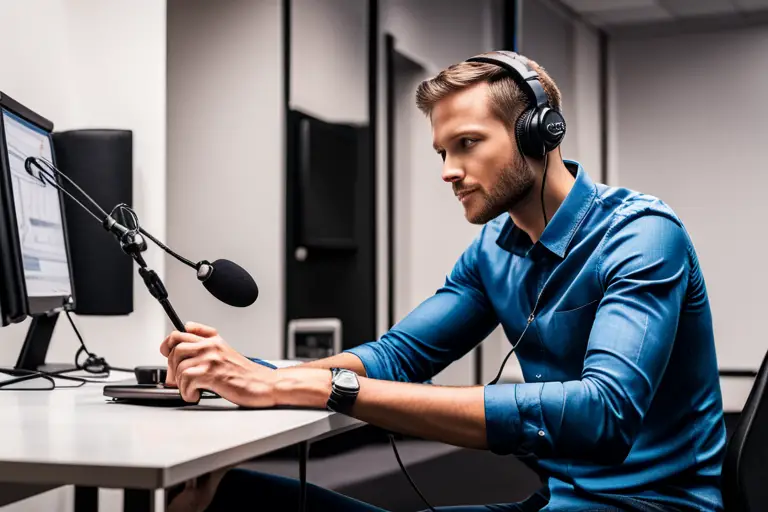Are you tired of posting videos on social media with poor audio quality? Whether you’re a content creator, influencer, or just someone who loves sharing moments with friends and family, recording high-quality audio on your phone is essential for a successful post.
But with limitations on your phone’s microphone, how can you achieve the best sound possible? In this article, we’ll guide you through the steps to record high-quality audio on your phone for social media.
First, it’s important to understand your phone’s microphone limitations. While most smartphones come with built-in microphones, they often struggle to capture clear audio in noisy environments or from a distance.
Investing in an external microphone can make a significant difference in your audio quality. But with so many options available, it can be overwhelming to choose the right one. Don’t worry, we’ll help you find the perfect microphone for your needs.
So, let’s get started!
Understanding Your Phone’s Microphone Limitations
If you’re serious about recording high-quality audio for your social media content, it’s important to understand the limitations of your phone’s microphone. While modern smartphones come equipped with decent microphones, they are still limited in terms of their performance. This is especially true when it comes to recording audio in noisy or crowded environments.
The biggest limitation of your phone’s microphone is its sensitivity to background noise. This means that it will pick up any sounds in the environment, including the sound of people talking, traffic noise, and other ambient sounds. Additionally, the microphone may not be able to capture audio that is too quiet or too loud, resulting in distorted or muffled recording.
Understanding these limitations will help you to work around them and improve the overall quality of your recordings.
Investing in an External Microphone
Improving the sound of your videos is possible by adding an external microphone. It enhances the audio quality and makes your content stand out. While your phone’s built-in microphone may suffice for basic recordings, an external microphone will provide you with better clarity, depth, and range. It will also reduce unwanted background noises and wind interference, resulting in a more professional-sounding audio.
When choosing an external microphone, you should consider the type of content you create, the environment in which you record, and your budget. There are different types of external microphones, such as lavalier, shotgun, and condenser microphones, each with their own unique features and benefits. You can also find affordable options that are compatible with your phone’s audio jack or lightning port, or invest in wireless microphones that offer more flexibility and mobility.
Whatever your choice may be, adding an external microphone to your recording setup will undoubtedly take your social media content to the next level.
Choosing the Right Microphone for Your Needs
Don’t settle for mediocre sound on your videos – selecting the perfect external microphone for your content can make all the difference in captivating your audience.
When choosing a microphone, consider the type of content you create and the environment in which you record. If you’re recording in a noisy environment, a directional microphone that picks up sound from a specific direction may be the best option. If you’re recording interviews or conversations, a lavalier microphone that clips onto clothing and picks up sound from the speaker’s mouth may be more appropriate.
Another factor to consider is the type of connector your phone has. Some microphones require a lightning connector, while others use a headphone jack. Make sure to check your phone’s specifications before purchasing a microphone.
Additionally, consider the microphone’s size and portability. If you plan on recording on-the-go, a compact and lightweight microphone may be more convenient.
By taking the time to choose the right microphone for your needs, you can ensure that your audio quality is top-notch and your content stands out on social media.
Finding a Quiet Recording Location
To capture your audience’s attention and create a professional video, make sure to find a quiet location for recording.
Look for a space that is free from external noises, such as traffic, people talking, or animals making noise. If you’re recording indoors, turn off any appliances or devices that may create background noise, like fans or air conditioners.
Once you’ve found a quiet location, try to reduce any echo or reverb that may affect the audio quality. You can do this by adding soft materials to the room, like pillows or blankets, to absorb the sound.
If you’re recording outside, consider using a windscreen or pop filter to reduce wind noise and plosives. Remember, the quieter the environment, the better your audio quality will be, so take the time to find the best location for your recording.
Using Soundproofing Materials for Improved Audio
If you want to take your video recording to the next level, you can use soundproofing materials to enhance your audio experience. These materials can be found online or at your local hardware store and are easy to install.
Some common options include foam panels, acoustic curtains, and rubber mats. Foam panels are a popular choice for soundproofing as they absorb sound waves and reduce echo. They come in various sizes and thicknesses, making them easy to customize to fit your recording space.
Acoustic curtains are another option that can be hung over windows and doors to block out outside noise. And if you’re on a budget, rubber mats can be placed on the ground to absorb vibrations from footsteps and furniture.
By using soundproofing materials, you can eliminate unwanted background noise and capture high-quality audio that will make your videos stand out on social media.
Adjusting Recording Settings for Optimal Sound Quality
You can easily enhance the sound quality of your recordings by adjusting the settings on your device, allowing your audience to feel fully immersed in the sounds of your content.
First, ensure that your microphone is set to record in stereo mode. This will capture sound from all directions, resulting in a more natural and immersive audio experience for your followers.
Additionally, increasing the microphone sensitivity can help to pick up even the slightest sounds, providing a clearer and more detailed recording.
Another important setting to adjust is the bitrate. Increasing the bitrate will result in a higher quality audio file, but also a larger file size. This is particularly important if you plan on editing your recording later, as a higher bitrate will provide more flexibility in post-production.
Lastly, consider using a windscreen or pop filter to reduce any unwanted background noise or popping sounds.
By making these simple adjustments, you can create high-quality audio recordings that will captivate your audience and keep them coming back for more.
Editing and Enhancing Your Audio for Social Media
Editing and enhancing audio can add an extra layer of professionalism and depth to your social media content. Once you’ve recorded your audio, it’s time to edit it. You can use several free and paid apps for editing your audio, such as Audacity, GarageBand, or Adobe Audition. These apps allow you to cut, trim, and fade your audio, adjust the volume, and add effects like reverb or EQ.
Editing can help you remove any unwanted noises or mistakes, and make your recording sound more polished.
In addition to editing, you can also enhance your audio to make it stand out on social media. Enhancing means improving the overall quality of your recording.
One way to enhance your audio is by adding background music or sound effects that complement your narration or dialogue. You can find royalty-free music and sound effects online, or record them yourself using a microphone and some household objects.
Another way to enhance your audio is by using a plugin or a preset that can boost the bass, treble, or clarity of your recording. However, be careful not to overdo it, as too much enhancement can make your audio sound artificial or distorted.
Frequently Asked Questions
Can I record high-quality audio on my phone without using an external microphone?
Yes, you can record high-quality audio on your phone without using an external microphone. Ensure you are in a quiet environment, hold your phone close to your mouth, and adjust the recording settings for best results.
How can I improve the sound quality of my phone’s built-in microphone?
To improve your phone’s built-in microphone sound quality, try recording in a quiet room, holding the phone close to your mouth, and avoiding background noise. Additionally, consider using a third-party app with noise reduction features.
What are some common mistakes people make when recording audio on their phone for social media?
“When recording audio on your phone for social media, common mistakes include not checking the microphone placement, not monitoring the audio levels, and not using a windscreen. These can all lead to poor sound quality in your recordings.” ‘Additionally, failing to edit out background noise or using excessive filters can also negatively impact the overall sound quality of your social media audio recordings.’
How do I know if the location I’ve chosen for recording is quiet enough?
To determine if your location is quiet enough for recording, listen for background noise such as traffic, people talking, or appliances. Test record for a few seconds and listen back to check for unwanted sounds.
What are some tips for editing and enhancing audio specifically for social media platforms?
To edit and enhance audio for social media, try using filters and EQ adjustments to remove background noise and boost clarity. Use compression and normalization to balance volume levels. Add sound effects and music to make your content more engaging.
Conclusion
Congratulations! You now know how to record high-quality audio on your phone for social media. By understanding your phone’s microphone limitations and investing in an external microphone, you can significantly improve the audio quality of your recordings.
Remember to choose the right microphone for your needs and find a quiet recording location. Use soundproofing materials and adjust recording settings for optimal sound quality.
And don’t forget to edit and enhance your audio before sharing it on social media. With these tips, your audience will be impressed with the professional sound quality of your recordings.
Happy recording!

Hey there, tech enthusiasts! I’m your go-to content writer, delving into the fascinating world of technology hacks. Get ready to unlock mind-blowing secrets and discover innovative solutions through my engaging and insightful blogs.


